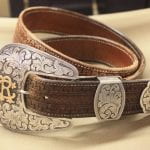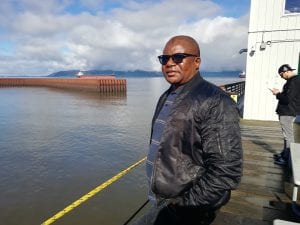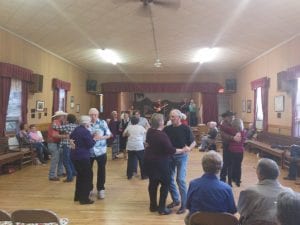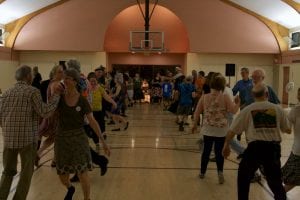Iris Teeuwen (photos and text) and Christal Snyder (text and editor)

Top starting from the left: Steve McKay, Marjan Anvari, Mic Crenshaw, Mark Ross, Brian Hart, Hossein Salahi, Antonio Huerta. Bottom Starting from the left: Feryal Abbasi-Ghnaim, Kelli Palmer, Esther Stutzman, Roberta Kirk, Marge Kalama, Azar Salehi, Maria de Jesus Gonzalez Laguna. Present at the gathering, but not photographed here: Charlotte Roderique, Wanda Johnson, Sandra Teeman
Oregon Folklife Network staff had the privilege of spending 2 days at Bend’s High Desert Museum at a professional development gathering with 17 of Oregon’s master traditional artists. Funding from the NEA and the Oregon Arts Commission and a generous partnership with the High Desert Museum provided support to invite our Traditional Arts Apprenticeship Program’s (TAAP) master artists (2011-2019) for peer-to-peer mentoring and professional development. On April 27-28, 2019, 17 of 32 master artists came together for networking, panel discussions, performances and demonstrations. As the artists noted, “It was wonderful to have this opportunity to get to know each other.” The gathering provided a “fantastic opportunity to connect – all of it was useful.”
Folk & Traditional Art Displays: The Gathering began with introductions. Several artists shared their pieces with the group.

Feryal Abbasi-Ghnaim (center) shows her traditional Palestinian embroidery to Persian tazhib artist, Marjan Anvari (right). Burns Paiute moccasin maker and tradition keeper Charlotte Roderique (left) chats to another artist.

Iranian traditional artist and conservator Marjan Anvari specializes in tazhib, a form of traditional manuscript illumination that dates back to 224 A.D. Because of its ubiquitous presence in Iran’s historical architecture, visual arts, and craftsmanship, tazhib has become a symbol of nationality and culture. Anvari has more than 15 years of experience working on manuscripts, books, and art on paper and is particularly dedicated to using her talents to educate children and adults. This particular piece, Anvari explained, is a runner that she decorated with “a combination of traditional Persian fabric (Termeh) and hand-painted Persian illumination (tazhib).” The motif is called shamseh (sun).

Cornhusk weaver Kelli Palmer (Warm Springs) uses dried cornhusk, hemp, yarn, and buckskin (brain-tanned and smoked deer hide) to make her traditional baskets. Palmer employs a double-twining technique to create traditional woven hats and sally bags or wapus (flat baskets); women wear the bags around their waists and use them to collect roots that they later dry and prepare for eating.

Marjorie Kalama (Warm Springs) makes traditional loomed beadwork. Her method of two-needled tack-down beading requires the simultaneous use of two needles with different sized threads. She adorns dresses, fans, and more with her intricately shaded designs. Kalama has won six awards for her beadwork at tribal member art shows.

H’Klumaiyat-Roberta Kirk (Wasco) is a traditional beadworker and regalia maker. Kirk uses shells and beadwork to embellishes traditional clothing that she designs and makes for ceremonies and pow-wows. Kirk also gathers traditional foods for the Simnasho Longhouse in Warm Springs and has consulted for several museums, including the Smithsonian, on Native American artifacts.

Ragalia makers Marge Kalama (Warm Springs) and Charlotte Roderique (Burns Paiute) admire Kelli Palmer’s traditional baskets.

Buckaroo and traditional saddle maker Steve McKay (right) shows Marge Kalama (left) one of his intricately braided rawhide lariats. McKay learned to tool saddles in the 1980s from fellow traditional artist Len Babb II; other Oregon buckaroos consider him the “go-to” guy for functional, well-made gear.

Antonio Huerta (Mexican charro/cowboy) examines one of Steve McKay’s braided rawhide ropes.

Antonio Huerta performs traditional charrería (cowboy rope work), an skill used to work cattle and in rodeo competitions.
Needs Assessment and Professional Development: OFN asked artists to let us know about areas in which they needed help as well as where they had strengths and could help others. Categories included promotions, finding gigs, business and finance, and expanding opportunities.

Tazhib (illumination and calligraphy) artist Marjan Anvari (Persian) is interested in assistance with online promotion.

Roberta Kirk and Maria de Jesus Gonzalez Laguna add their thoughts for a session on Looking Back/Looking Forward or the Traditional Arts Apprenticeship Program.

Antonio Huerta, who also does outreach for the UO Division of Undergraduate Studies, shares his ideas with fellow artists.

Charlotte Roderique (left), Wanda Johnson (center), and Sandra Teeman (right) are members of the Burns Paiute Tribe and skilled moccasin makers who have taught this traditional art to Burns Paiute children As members of the tribe’s Cultural Advisory Committee, these culture keepers have dedicated their time and effort to sustaining their heritage.

Charlotte Roderique takes her turn to talk with the group.

Feryal Abbasi-Ghnaim (standing), a 2018 National Heritage Fellow, learned traditional Palestinian embroidery the stories behind the designs from her mother and grandmother.

Emily West Hartlerode (standing), OFN Associate Director, facilitates a session about exploring resources that OFN and artists can share to support one other.

Michelle Seiler-Godfrey, Program Development Manager at the High Desert Museum, spoke to artists about marketing their arts and expanding their networks.
Performances: On Saturday evening everyone gathered at McMenamins Old St. Francis School to socialize and share their traditional arts.

First up to perform was old time musician Mark Ross, whose repertoire of over nearly 500 songs runs the gamut of American roots music, includes ballads, train songs, blues, and western swing.

Traditional Irish singer Brian Ó hAirt explores the Irish experience from the profane to the conventional through music. The continuing significance of Irish ballads and folk songs is evidenced by its popularity at any Irish gathering, whether at homes, in pubs or bars, and for community celebrations.

Master santoor player Hossein Salehi began his musical career at seven when he started learning this ancient traditional art form from his father, Maestro Abbas Salehi. The instrument is a trapezoid-shaped hammered dulcimer with 72 strings strung over small adjustable bridges; this makes it possible for the santoor, Iran’s national instrument, the capacity to produce a range of three octaves. This musical tradition is over 1100 years old.

Azar Salehi is an Persian storyteller who also recites traditional poetry. Salehi has partnered with Portland State University and others in her mission to connect members of the Iranian diaspora to their cultural roots.

MC Michael “Mic” Crenshaw is a poetry slam champion and a respected hip hop artist around the Northwest and in Africa. A former member of the Portland-based group Hungry Mob, Crenshaw currently acts as Political Director for the Hip Hop Congress and the Lead U.S. Organizer for the Afrikan Hip Hop Caravan. Crenshaw recently received one of four inaugural 2019-21 Fields Artist’s Fellowships from the Oregon Community Foundation in partnership with Oregon Humanities.

Traditional Coos and Kalapuya storyteller Esther Stutzman is an enrolled member of the Confederated Tribes of Siletz and a member of the Northwest Indian Storyteller’s Association. Stutzman was the winner of the 2017 Governor’s Arts Award for Lifetime Achievement.

At the conclusion to the TAAP Master Artist Gathering, Mexican Folkloríco dancer and teacher Maria de Jesus Gonzalez Laguna and Antonio Huerta collaborated on a performance that combined charrería with a traditional folklórico dance. Each of Mexico’s states has a set of traditional dances that feature specific expression, technique, dress, and accessories.

Echoing everyone’s sentiments, one of the artists commented, “the performances [and folk art displays were] all beautiful, and we will remember that for a long time.










































